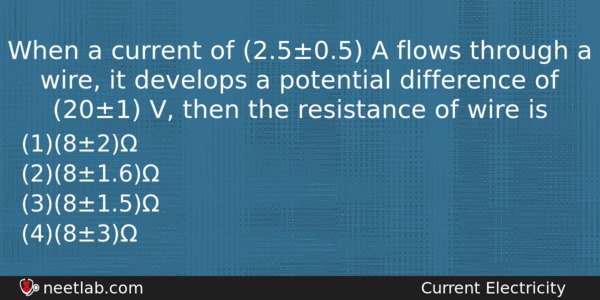| ⇦ | 
| ⇨ |
When a current of (2.5±0.5) A flows through a wire, it develops a potential difference of (20±1) V, then the resistance of wire is
Options
(a) (8±2)Ω
(b) (8±1.6)Ω
(c) (8±1.5)Ω
(d) (8±3)Ω
Correct Answer:
(8±2)Ω
Explanation:
No explanation available. Be the first to write the explanation for this question by commenting below.
Related Questions: - Light of wavelength λ is incident on slit of width d. The resulting diffraction
- A coil of N turns and mean cross-sectional area A is rotating with uniform angular
- The dimensional formula for Boltzmann’s constant is
- A moving neutron collides with a stationary α-particle.The fraction of the kinetic energy
- Reactance of a capacitor of capacitance C µF for A.C freqency (400 / π) Hz is 25 ohm
Topics: Current Electricity
(136)
Subject: Physics
(2479)
Important MCQs Based on Medical Entrance Examinations To Improve Your NEET Score
- Light of wavelength λ is incident on slit of width d. The resulting diffraction
- A coil of N turns and mean cross-sectional area A is rotating with uniform angular
- The dimensional formula for Boltzmann’s constant is
- A moving neutron collides with a stationary α-particle.The fraction of the kinetic energy
- Reactance of a capacitor of capacitance C µF for A.C freqency (400 / π) Hz is 25 ohm
Topics: Current Electricity (136)
Subject: Physics (2479)
Important MCQs Based on Medical Entrance Examinations To Improve Your NEET Score
18000+ students are using NEETLab to improve their score. What about you?
Solve Previous Year MCQs, Mock Tests, Topicwise Practice Tests, Identify Weak Topics, Formula Flash cards and much more is available in NEETLab Android App to improve your NEET score.
Share this page with your friends

R=V/I
R=20/2.5
R= 8 ohm
Now,
∆ R/R=∆ V/V+∆I/I
=1/20 +0.5/2.5
= 1/4
Therefore,
∆ R÷R=1÷4
∆ R=1÷4×R
∆R=1÷4×8
∆R=2
Therefore,
Resistance with error limits=R+ – ∆R
=(8+ – 2)ohm